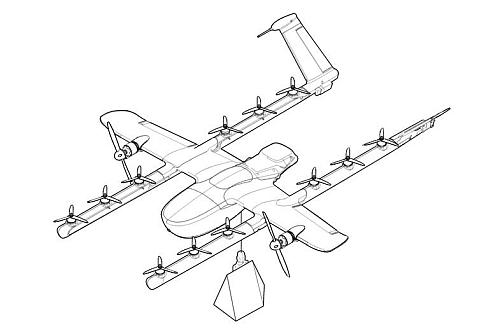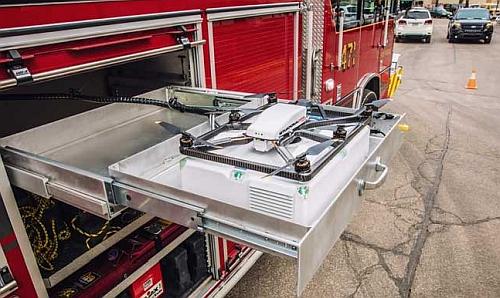Podcast: Play in new window | Download (Duration: 30:42 — 21.1MB)
An actively tethered UAS for situational awareness, a fixed-wing drone studies the atmosphere in Greenland, a larger “hive” drone releases a swarm of smaller “cicada” drones, Virgin Atlantic reports a drone near-hit, a drone that plants tree seeds, Wing receives FAA certification allowing delivery service in the US, and a drone powered by variable-buoyancy.
UAV News
Fotokite Launches Firefighter Situational Awareness System in Partnership with Pierce Manufacturing
The “Pierce Situational Awareness System by Fotokite” is an actively tethered UAS that integrates directly into public safety vehicles and firefighter operations. The Fotokite provides persistent aerial situational awareness and since they are tethered, no pilot licenses or authorizations to fly are required. The Pierce Fotokite systems have already been installed into Pierce fire apparatus, as well as command vehicles, and fire chiefs’ SUVs. The Fotokite Sigma Ground Station and Kite are available for first responders in general.
Black Swift UAS chosen for arctic research project in Greenland
The Institute of Arctic and Alpine Research, part of the University of Colorado Boulder, Is deploying Black Swift S2 drones from Boulder, Colorado-based Black Swift Technologies. They will conduct high-altitude, high-latitude atmospheric research studies in Greenland and create vertical profiles of the Arctic atmosphere. This will help understand how sublimation into the atmosphere affects climate conditions. The project is supported by the National Science Foundation and is part of the larger international East Greenland Ice-Core Project, or EastGRIP.
See NASA test a swarm of 100 US Navy Cicada drones
NASA’s Langley Research Center released a video showing four large “Hive” drones releasing over 100 smaller “Cicada” drones. The Cicada is a “Close-In Covert Autonomous Disposable Aircraft” and they fit in the palm of your hand. The Navy says, “Cicada is a concept for a low-cost, GPS-guided, micro disposable air vehicle that can be deployed in large numbers to ‘seed’ an area with miniature electronic payloads.” NASA is looking at the Cicadas as tools for meteorologists with sensors that measure temperature, air pressure, and wind-speed.
Video: It’s Raining Drones! NASA drops 100 drones tiny enough to fit in your hand
Virgin Atlantic jet carrying 264 passengers ‘came within SECONDS of crashing into two drones at 14,000ft as it approached to land at Heathrow’
The B787 Dreamliner with 264 passengers was flying at 320 mph over Essex when two drones were spotted. One drone was estimated to be 90 feet from the aircraft.
These tree-planting drones are firing seed missiles to restore the world’s forests
BioCarbon Engineering drones have been planting mangrove trees in Myanmar. The drones map the area, collect topography and data on soil condition, and combine that with satellite data. An analysis is performed that determines the best locations for the seeds, and the drone fires biodegradable pods into the ground. We had previously talked about a similar capability from Seattle-based DroneSeed.
Alphabet’s Wing becomes first drone delivery firm to win FAA approval in the US
As previously speculated, Alphabet’s Wing unit received Air Carrier Certification from the FAA. Wing is the first drone delivery company receiving this certification in the US, and it allows the company to start a commercial delivery service with drones. Wing plans to start the service in Blacksburg and Christiansburg, Virginia over the next few months. See also, Wing becomes first certified Air Carrier for drones in the US.

Ultra-long endurance UAV flies using variable-buoyancy propulsion
The Phoenix ultra-long endurance autonomous UAV is powered by variable-buoyancy propulsion. It creates thrust by alternating between being lighter than air and heavier than air.
Researchers at the University of the Highlands and Islands in the UK use electrically-powered pumps and valves in the Phoenix.
Video: Phoenix: UK team trials first large-scale aircraft powered by variable-buoyancy propulsion.

